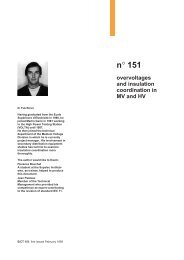LV generator protection - engineering site - Schneider Electric
LV generator protection - engineering site - Schneider Electric
LV generator protection - engineering site - Schneider Electric
Create successful ePaper yourself
Turn your PDF publications into a flip-book with our unique Google optimized e-Paper software.
3.1.2. Short-circuit current <strong>protection</strong>3.1.2.1. Making the short-circuit currentThe short-circuit current is the sum:b of an aperiodic currentb of a damped sinusoidal current.The short-circuit current equation shows that it is made according to threephases.E79365EI rms 1subtransientconditions2transientconditions3steady stateconditions<strong>generator</strong> withcompoundexcitation orover-excitation<strong>generator</strong> withserial exitationfaultappears10 to 20 ms0.1 to 0.3 sFigure 14: Short-circuit current level during the 3 phases.Subtransient phaseWhen a short-circuit appears at the terminals of a <strong>generator</strong>, the current is firstmade at a relatively high value of around 6 to 12 ln during the first cycle(0 to 20 milliseconds).The amplitude of the short-circuit output current is defined by three parameters:b the subtransient reactance of the <strong>generator</strong>b the level of excitation prior to the time of the fault andb the impedance of the faulty circuit.The short-circuit impedance of the <strong>generator</strong> to be considered is the subtransientreactance expressed as a % of Uo (phase-to-neutral voltage) by themanufacturer x”d. The typical value is 10 to 15 %.We determine the subtransient short-circuit impedance of the <strong>generator</strong>:UX"d2 n x"d= where S = 3US 100NI N.Transient phaseThe transient phase is placed 100 to 500 ms after the time of the fault. Startingfrom the value of the fault current of the subtransient period, the current drops to1.5 to 2 times the current ln.The short-circuit impedance to be considered for this period is the transientreactance expressed as a % Uo by the manufacturer x'd. The typical value is 20to 30 %.Steady state phaseThe steady state occurs above 500 ms.When the fault persists, Set output voltage collapses and the exciter regulationseeks to raise this output voltage. The result is a stabilised sustained short-circuitcurrent:b if <strong>generator</strong> excitation does not increase during a short-circuit (no field overexcitation)but is maintained at the level preceding the fault, the current stabilisesat a value that is given by the synchronous reactance Xd of the <strong>generator</strong>. Thetypical value of xd is greater than 200 %. Consequently, the final current will beless than the full-load current of the <strong>generator</strong>, normally around 0.5 ln.b If the <strong>generator</strong> is equipped with maximum field excitation (field overriding) orwith compound excitation, the excitation “surge” voltage will cause the faultcurrent to increase for 10 seconds, normally to 2 to 3 times the full-load currentof the <strong>generator</strong>.T (s)17
















